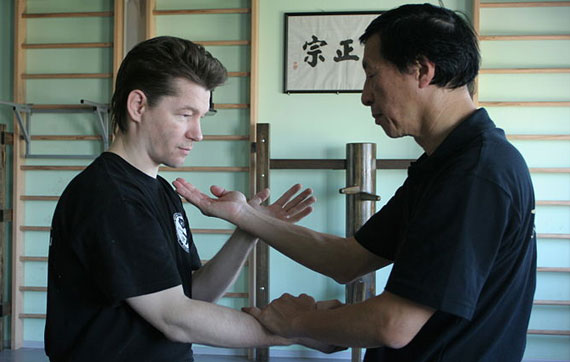
How to Use Chi Sao to Become a Great Fighter
October 24, 2012
“…Sadly a lot of what I see on You Tube, is “chasing the hands”, which is a serious mistake. Wing Chun strives to always attack the opponent’s center line … all attacks should be directed at the center line and not at the opponent’s limbs … The big danger in chasing the hands is that opportunities to attack are missed. The fighter instead becomes a puppet moving his hands where his opponent leads him…”
Nick Palmer
Chi Sao is the most misunderstood aspect of Wing Chun.
It is used to express aggression. It’s used while while talking and socializing. It is used to show off.
The following are issues that I am currently working on and struggling to integrate into my practice. A lot of what I know about it comes from my teacher (Greg LeBlanc) telling me that I’m not doing it. So my training lately has all been developing my Chi Sao capabilities so I can train properly.
Lets start at the bottom and work our way up.
You must approach Chi Sao the way golfers approach going to the driving range. You are going to practice distinct elements of fighting, using a tool that isolates elements of it.
Chi Sao is not fighting. Fighting has no rules. Chi Sao has lots of rules. It begins in contact – the bridge is given to you “for free.” In fighting, you must seek the bridge. So – rule one. Chi Sao is a training tool, not fighting.
You must start with a solid Yee Gee Kim Yeung Ma (also called the Character Two Aduction Stance or goat-clamping stance or horse stance) in order to ground your actions. Adduction means ” a movement which brings a part of the anatomy closer to the middle sagittal plane of the body.” In this case, it is your knees approaching the center line.
“Punching comes from the heart and power comes from the ground.” You must always tie the ground into your actions. Everything must flow down to the ground through your power chain (elbow to hip to knee to ankle to heel).
At the point of contact (the bridge), where your Tan Sao meets his low Fook and his Bong meets your high Fook, you must have a feeling of being pressed against his center of gravity, of being connected to his body so that if you push forward with your arms, he is moved back onto his heels, or into the ground if he is well-grounded.
You must “lock horns” with your opponent, but not let your power “pass over,” that is, do not lean forward, breaking at the hip, so that you are tipping forward and leaning on your training partner. The pressure forward should be steady and solidly rooted in the ground through your heel, but you must retain sensitivity and don’t try to muscle it.
In Wing Chun, your power must come from your legs and hips, not your upper body. This is why they suggest you fight “like a woman.” Train like someone who does not have a lot of upper body strength. You need to take your power out of the equation in order to learn how to fight with skill and finesse.
The number one complaint in Chi Sao is “I don’t know what to do next.” You do two or three techniques and then you and your partner lock up and suddenly you are doing standing grappling. This is not what you are training to learn! You must avoid this strength against strength struggle.
In order to get away from this dead-end method of training, you need to go back to your drill training. What did you learn there? If I’m covered, I can Kwan Sao. If someone captures the center line with a Fook action, I can change the angle by turning. You must remember that you are not fighting – you’re training. Its your job to help your training partner past these sticking points and its their job to help you – you are not competing, you’re cooperating. Its like spotting weights in the gym or holding the striking pad.
Let them do their action. You do your response, the one your drill training tells you is the right response for this action. You will suck at first. You will be late. Let him “win.” You need to both be performing clean, clear actions and then waiting for the response.
Later on, when you are really good at Chi Sao, maybe you can agree to train in a more combative manner and then, if they are slow or clumsy, maybe you cover and hit, fook and hit, and run over them. But in Chi Sao training , you must learn to wait for their action and then force yourself to use a clean and correct response.
It will be awkward and wobbly and slow at first. Every action is like a baby colt when its born. Then it learns to walk and then to run. Understand your Wing Chun is not born with mastery. Your Wing Chun will be wobbly and weak at first. Let it grow at its own pace.
More in Part Two.
